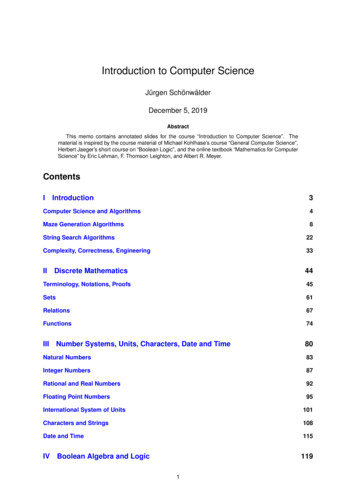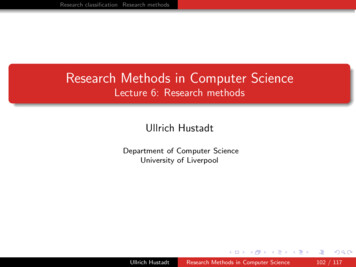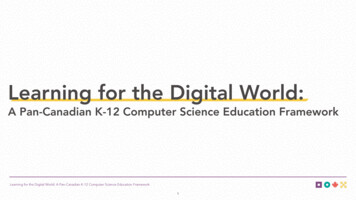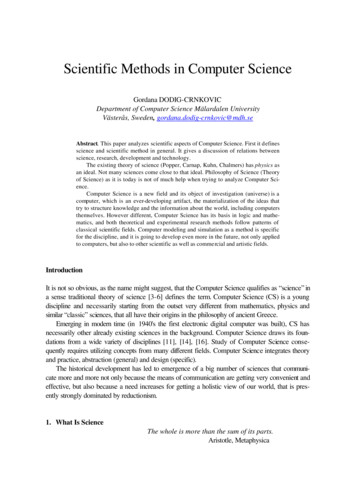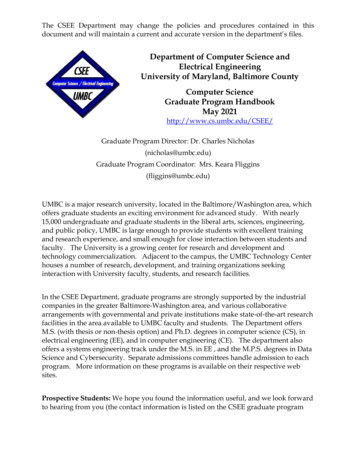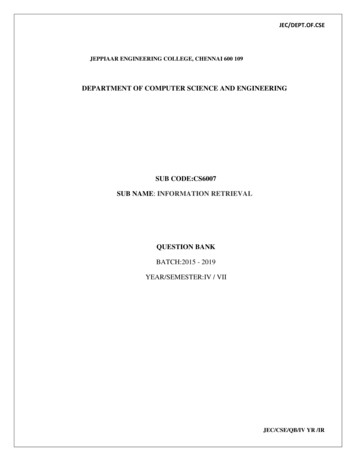
Transcription
JEC/DEPT.OF.CSEJEPPIAAR ENGINEERING COLLEGE, CHENNAI 600 109DEPARTMENT OF COMPUTER SCIENCE AND ENGINEERINGSUB CODE:CS6007SUB NAME: INFORMATION RETRIEVALQUESTION BANKBATCH:2015 - 2019YEAR/SEMESTER:IV / VIIJEC/CSE/QB/IV YR /IR
JEC/DEPT.OF.CSEJEPPIAAR ENGINEERING COLLEGE, CHENNAI 600 109DEPARTMENT OF COMPUTER SCIENCE AND ENGINEERINGACADEMIC YEAR 2017 – 2018 (ODD SEMESTER)SYLLABUSCS6007INFORMATION RETRIEVALLTPC3003UNIT IINTRODUCTION9Introduction -History of IR- Components of IR – Issues –Open source Search engine Frameworks –The impact of the web on IR – The role of artificial intelligence (AI) in IR – IR Versus Web Search– Components of a Search engine- Characterizing the web.UNIT IIINFORMATION RETRIEVAL9Boolean and vector-space retrieval models- Term weighting – TF-IDF weighting- cosine similarity– Preprocessing – Inverted indices – efficient processing with sparse vectors – Language Modelbased IR – Probabilistic IR –Latent Semantic Indexing – Relevance feedback and query expansion.UNIT IIIWEB SEARCH ENGINE – INTRODUCTION AND CRAWLING9Web search overview, web structure, the user, paid placement, search engine optimization/spam. Web size measurement – search engine optimization/spam – Web Search Architectures –crawling – meta-crawlers- Focused Crawling – web indexes –- Near-duplicate detection – IndexCompression – XML retrieval.AULibrary.comUNIT IVWEB SEARCH – LINK ANALYSIS AND SPECIALIZED SEARCH9Link Analysis –hubs and authorities – Page Rank and HITS algorithms -Searching and Ranking –Relevance Scoring and ranking for Web – Similarity – Hadoop& Map Reduce – Evaluation –Personalized search – Collaborative filtering and content-based recommendation of documents andproducts – handling “invisible” Web – Snippet generation, Summarization, Question Answering,Cross- Lingual Retrieval.UNIT VDOCUMENT TEXT MINING9Information filtering; organization and relevance feedback – Text Mining -Text classificationand clustering – Categorization algorithms: naive Bayes; decision trees; and nearest neighbor –Clustering algorithms: agglomerative clustering; k-means; expectation maximization (EM).TOTAL: 45JEC/CSE/QB/IV YR /IR
JEC/DEPT.OF.CSETEXT BOOKS:1. C. Manning, P. Raghavan, and H. Schütze, Introduction to Information Retrieval ,Cambridge University Press, 2008.2. Ricardo Baeza -Yates and BerthierRibeiro – Neto, Modern Information Retrieval: TheConcepts and Technology behind Search 2nd Edition, ACM Press Books 2011.3. Bruce Croft, Donald Metzler and Trevor Strohman, Search Engines: Information Retrievalin Practice, 1st Edition Addison Wesley, 2009.4. Mark Levene, An Introduction to Search Engines and Web Navigation, 2nd Edition Wiley, 2010.REFERENCES:1. Stefan Buettcher, Charles L. A. Clarke, Gordon V. Cormack, Information Retrieval:Implementing and Evaluating Search Engines, The MIT Press, 2010.2. OphirFrieder “Information Retrieval: Algorithms and Heuristics: The Information RetrievalSeries “, 2nd Edition, Springer, 2004.3. Manu Konchady, “Building Search Applications: Lucene, Ling Pipe”, and First Edition, GateMustru Publishing, 2008.JEC/CSE/QB/IV YR /IR
JEC/DEPT.OF.CSEUNIT – IINTRODUCTIONPART – AQUESTIONS AND ANSWERS1. Define information retrieval.(nov/dec 2016)Information retrieval (IR) is finding material (usually documents) of an unstructured nature (usuallytext) that satisfies an information need from within large collections (usually stored on computers).2. What are the applications of IR? Indexing Ranked retrieval Web search Query processing3. Give the historical view of Information Retrieval. Boolean model, statistics of language (1950’s) Vector space model, probabilistic indexing, relevance feedback (1960’s) Probabilistic querying (1970’s) Fuzzy set/logic, evidential reasoning (1980’s) Regression, neural nets, inference networks, latent semantic indexing, TREC (1990’s)4. What are the components of IR?(nov/dec 2016) The document subsystem The indexing subsystem The vocabulary subsystem The searching subsystem The ser-system interface The matching subsystem5. How to AI applied in IR systems?(nov/dec 2016)Four main roles investigated Information characterisationSearch formulation in information seekingSystem IntegrationJEC/CSE/QB/IV YR /IR
JEC/DEPT.OF.CSE Support functions6. How to introduce AI into IR systems? User simply enters a query, suggests what needs to be done, and the system executes thequery to return results. First signs of AI. System actually starts suggesting improvements to user. Full Automation. User queries are entered and the rest is done by the system.7. What are the areas of AI for information retrieval? Natural language processing Knowledge representation Machine learning Computer Vision Reasoning under uncertainty Cognitive theory8. Give the functions of information retrieval system. To identify the information(sources) relevant to the areas of interest of the target userscommunity To analyze the contents of the sources(documents) To represent the contents of the analyzed sources in a way that will be suitable for matchinguser’s queries To analyze user’s queries and to represent them in a form that will be suitable for matchingwith the database To match the search statement with the stored database To retrieve the information that is relevant To make necessary adjustments in the system based on feedback form the users.9. List the issues in information retrieval system. Assisting the user in clarifying and analyzing the problem and determining informationneeds. Knowing how people use and process information. Assembling a package of information that enables group the user to come closer to asolution of his problem. Knowledge representation. Procedures for processing knowledge/information. The human-computer interface. Designing integrated workbench systems.JEC/CSE/QB/IV YR /IR
JEC/DEPT.OF.CSE Designing user-enhanced information systems.System evaluation.10. What are some open source search frameworks? Google Search API Apache Lucene blekko API Carrot2 Egothor Nutch11. Define relevance.Relevance appears to be a subjective quality, unique between the individual and a given documentsupporting the assumption that relevance can only be judged by the information user.Subjectivityand fluidity make it difficult to use as measuring tool for system performance.12. What is meant by stemming?Stemming is techniques used to find out the root/stem of a word. Used to improve effectiveness ofIR and text mining.Stemming usually refers to a crude heuristic process that chops off the ends ofwords in the hope of achieving this goal correctly most of the time, and often includes the removalof derivational affixes.13. Define indexing & document indexing.Association of descriptors (keywords, concepts, metadata) to documents in view of future retrieval.Document indexing is the process of associating or tagging documents with different “search”terms. Assign to each document (respectively query) a descriptor represented with a set of features,usually weighted keywords, derived from the document (respectively query) content.14. Discuss the impact of IR on the web.The impacts of information retrieval on the web are influenced in the following areas. Web Document CollectionSearch Engine OptimizationVariants of Keyword StuffingDNS cloaking: Switch IP addressSize of the WebSampling URLsRandom Queries and SearchesJEC/CSE/QB/IV YR /IR
JEC/DEPT.OF.CSE15. List Information retrieval models.(nov/dec 2016) Boolean model Vector space model Statistical language model16. Define web search and web search engine.Web search is often not informational -- it might be navigational (give me the url of the site I antto reach) or transactional (show me sites where I can perform a certain transaction, e.g. shop,download a file, or find a map).Web search engines crawl the Web, downloading and indexing pages in order to allow full-textsearch. There are many general purpose search engines; unfortunately none of them come close toindexing the entire Web. There are also thousands of specialized search services that index specificcontent or specific sites.17. What are the components of search engine?Generally there are three basic components of a search engine as listed below:1. Web Crawler2. Database3. Search Interfaces18. Define web crawler.This is the part of the search engine which combs through the pages on the internet and gathers theinformation for the search engine. It is also known as spider or bots. It is a software component thattraverses the web to gather information.19. What are search engine processes?Indexing Process Text acquisitionText transformationIndex creationQuery Process User interactionRankingEvaluationJEC/CSE/QB/IV YR /IR
JEC/DEPT.OF.CSE20. How to characterize the web?Web can be characterized by three forms Search engines -AltaVistaWeb directories -YahooHyperlink search-Web Glimpse21. What are the challenges of web? Distributed data Volatile data Large volume Unstructured and redundant data Data quality Heterogeneous dataJEC/CSE/QB/IV YR /IR
JEC/DEPT.OF.CSEPART – BQUESTIONS AND ANSWERS1. Write about history of Information Retrieval. Early keyword-based engines ca. 1995-1997 1998 : Link-based ranking pioneered by Google Altavista, Excite, Infoseek, Inktomi, LycosBlew away all early engines save Inktomi2005 : Google gains search share, dominating in Europe and very strong in North America 2009: Yahoo! and Microsoft propose combined paid search offering2. Explain the Information Retrieval. (nov/dec 2016)IR helps users find information that matches their information needs expressed as queries.Historically, IR is about document retrieval, emphasizing document as the basic unit.– Finding documents relevant to user queries.Architecture of Information RetrievalIR Queries Keyword queries Boolean queries (using AND, OR, NOT) Phrase queries Proximity queries Full document queries Natural language questionsIR Models– Boolean modelJEC/CSE/QB/IV YR /IR
JEC/DEPT.OF.CSE– Vector space model– Statistical language model3. Discuss the influence of AI in Information Retrieval.Areas of AI for IR Natural language processingKnowledge representation Expert systems Ex: Logical formalisms, conceptual graphs, etcMachine learning Short term: over a single session Long term: over multiple searches by multiple usersComputer Vision Ex: OCRReasoning under uncertainty Ex: Dempster-Shafer, Bayesian networks, probability theory, etcCognitive theory Ex: User modellingAI applied to IR Four main roles investigated Information characterisation Search formulation in information seeking System Integration Support functions AI has a very valuable contribution to make Specialised systems where domain is controlled, well-integrated and understood Support functions Case-based reasoning and dialogue functions Integrated functions4. Explain in detail about Search Engine.Search Engine is in the field of IR .Searching authors, titles and subjects in library card catalogs orcomputers. Document classification and categorization, user interfaces, data visualization, filteringTypes of Search Engines Search by Keywords (e.g. AltaVista, Excite, Google, and Northern Light) Search by categories (e.g. Yahoo!) Specialize in other languages (e.g. Chinese Yahoo! and Yahoo! Japan) Interview simulation (e.g. Ask Jeeves!)JEC/CSE/QB/IV YR /IR
JEC/DEPT.OF.CSESearch Engine Architectures AltaVista Harvest GoogleAltaVista ArchitectureHarvest ArchitectureGoogle ArchitectureModern Search EngineJEC/CSE/QB/IV YR /IR
JEC/DEPT.OF.CSE5. Discuss web information retrieval system.Web Search Engine Evolution Web Search 1.0 –Traditional Text Retrieval Web Search 2.0 –Page-level Relevance Ranking Next Generation Web SearchWeb Analysis and Its Relationship to IR Goals of Web analysis: Improve and personalize search results relevance Identify trendsClassify Web analysis: Web content analysis Web structure analysis Web usage analysisSearching the WebAnalyzing the Link Structure of Web PagesWeb Content AnalysisTrends in Information RetrievalFaceted search Allows users to explore by filtering available information Facet :Defines properties or characteristics of a class of objects Social search New phenomenon facilitated by recent Web technologies: collaborative socialsearch, guided participationJEC/CSE/QB/IV YR /IR
JEC/DEPT.OF.CSEUNIT IIINFORMATION RETRIEVALPART – AQUESTIONS AND ANSWERS1.What are the three classic models in information retrieval system?1.Boolean model2.Vector Space model3.Probabilistic model2.What is the basis for boolean model?Simple model based on set theory and Boolean algebra Documents are sets of terms Queries are specified as Boolean expressions on terms3.How can we represent the queries in boolean model?Queries specified as boolean expressions Precise semantics Neat formalism q ka (kb kc)4.Definition of boolean model?Index term weight variables all are binary wij {0,1} Query q ka (kb kc) sim(qi,dj) 1 , i.e. doc’s are relevantJEC/CSE/QB/IV YR /IR
JEC/DEPT.OF.CSE0, otherwise i.e. doc’s are not relevantq ka (kb kc) , can be written as disjunctive normal form,vec(qdnf) (1,1,1) v (1,1,0) v (1,0,0)5. What are the advantages of Boolean model? Clean Formalism Easy to implement Intuitive concept Still it is dominant model for document database systems6.What are the disadvantages of Boolean model?Exact matching may retrieve too few or too many documents Difficult to rank output, some documents are more important than others Hard to translate a query into a Boolean expression All terms are equally weighted More like data retrieval than information retrieval No notion for partial matching7.Define the Vector ModelThis model recognizes that the Use of binary weights is too limiting and proposes aframework in which partial matching is possible. Non-binary weights provide consideration for partial matches These term weights are used to compute a degree of similaritybetween a queryand each document Ranked set of documents provides for better matching wi,j 0 associated with the pair (ki,dj) vec(dj) (w1,j, w2,j, ., wt,j) Wi,q 0 associated with the pair (ki,q) vec(q) (w1,q, w2,q, ., wt,q) t- total no. Of index terms in the collectionJEC/CSE/QB/IV YR /IR
JEC/DEPT.OF.CSE Sim(dj, q) dj q dj x q t (wi, j x wi,q)i 1tt wi, j x wi,q2i 12j 18. What are the advantages ofVector Model? Simple model based on linear algebra Term weights not binary Allows computing a continuous degree of similarity between queries anddocuments Allows ranking documents according to their possible relevance Allows partial matching Allows efficient implementation for large document collections8. What are the disadvantages ofVector Model? Index terms are assumed to be mutually independent Search keywords must precisely match document terms Long documents are poorly represented The order in which the terms appear in the document is lost in the vector spacerepresentation Weighting is intuitive, but not very formal9. What are the Parameters in calculating a weight for a document term or query term?Term Frequency (tf): Term Frequency is the number of times a term i appears indocument j (tfij )– Document Frequency (df): Number of documents a term i appears in, (dfi ).– Inverse Document Frequency (idf): A discriminating measure for a term i incollection, i.e., how discriminating term i is. (idf i) log10(n / dfi), where n is thenumber of document10. How can you calculate tf and idf in vector model? The normalized frequency (term factor) fi,jis,JEC/CSE/QB/IV YR /IR
JEC/DEPT.OF.CSEfi,j freqi,j / maxlfreql,j; if ki not appear in dj then fi,j 0; Inverse document frequency (idf) isidfi log(N/ni) or idfi log(D/dfi)Where N- total no.of documents in the collection ni – no.of documents in which the index terms ki appears freqi,j – frequency of the term ki in the document dj maxl – maximum over all terms frequencies11.How do you calculate the term weighting in document and Query term weight ?(nov/dec2016) Trem weighting is, wi,j tf * idfii.e. wij fi,j * log(N/ni) Query term weight is, wi,q (0.5 0.5 *freqi,q / maxlfreql,q ) * log(N/ni)12.Write the cosine similarity function for vector space model:Q.DCosine ɵ Q . D 13.Define Probabilistic model or Binary Independence Retrieval :The Objectiveof Probabilistic model is to capture the IR problem using a probabilisticframeworkGiven a user query, there is an ideal answer set Querying as specification of the properties of this ideal answer set Definition Weight variables all are binary, i.e. wi,j {0,1} and wi,q {0,1} q- a query is a subset of index termsJEC/CSE/QB/IV YR /IR
JEC/DEPT.OF.CSE R – set of doc’s known (initial guess) to be relevant R – the complement of R, i.e. the set of non-relevant doc’s P(R dj) – probability of dj relevant to q P(R dj) - probability of dj non-relevant to q sim(dj,q) P(R dj) / P(R dj)14.What are the Fundamental assumptions for probabilistic principle? q- user query,dj – doc in the collections Model assumes, relevance depends on the query and the doc representation only R – ideal answer set, relevant to the query R - ideal answer set, non-relevant to the query Similarity to the query ratio is, i.e. probabilistic ranking computed as Ratio P(dj relevant-to q) / P(dj non-relevant-to q) The rank minimizes the probability of the erroneous judgment15. How can you find similarity between doc and query in probabilistic principleUsingBayes’ rule?sim(dj,q) P(dj R) x P(R) / P(dj R) x P(R)whereP(dj R) - probability of randomly selecting the document dj from the set R ofrelevant documents P(R) - probability of randomly selecting the document from the entire collection isrelevantThe meaning of P(dj R) and P(R) are analogous and complementary Since P(R) and P(R) are same for all doc’s in the collection, then we write,sim(dj,q) P(dj R) / P(dj R)16.Write the advantages and disadvantages of probabilistic model: AdvantagesJEC/CSE/QB/IV YR /IR
JEC/DEPT.OF.CSE Doc’s are ranked in decreasing order of their probability of relevant Disadvantages Need to guess the initial separation of doc’s into relevant and nonrelevant sets All weights are binary The adoption of the independence assumption for index terms need to guess initial estimates for P(ki R) method does not take into account tf and idf factors17.Why theClassic IR might lead to poor retrieval? The user information need is more related to concepts and ideas than to indexterms but in classic IR Unrelated documents might be included in the answer set Relevant documents that do not contain at least one index term are not retrieved Reasoning: retrieval based on index terms is vague and noisy18.Definitions Latent Semantic Indexing Model:o Let t be the total number of index termso Let N be the number of documentso Let vec(M) Mij be a term-document matrix with t -rows and N -columnso To each element of this matrix is assigned a weight wij associated with thepair [ki,dj]o The weight wij can be based on a tf-idf weighting scheme19.Write the advantages of Latent Semantic Indexing Model? Latent semantic indexing provides an interesting conceptualization of the IR problem It an efficient indexing scheme for the documents in te collection It provides, Elimination of noise Removal of redundancy20.Define Relevance feedback model:-(nov/dec 2016)JEC/CSE/QB/IV YR /IR
JEC/DEPT.OF.CSEAfter initial retrieval results are presented allow the user to provide feedback on therelevance of one or more of the retrieved documents. use this feedback information toreformulate the query and produce new results based on reformulated query. Thus allowsmore interactive multi pass process.21.Draw the flow diagram for relevance feedback query processing model:(nov/dec 2016)22. Write the types of queries:There are 4 type of queries such as Structured queries,Pattern matching queries,Booleanqueries,Context Queries23.Give short notes for User Relevance Feedback:It is the most popular query formulation strategy. In a relevance feed backcycle ,the userpresented with a list of the retrieved documents .Then examine them, marks those which arerelevantOnly to 10 (or 20 ) ranked documents are examinedo Selecting important terms, or expression, attached to the documentso Enhancing the important of these terms in a new query formulationoThe new query will be 1.Moved towards the relevant documents,2.Away from the non-relevantones.24.What are the two basic approaches in User Relevance Feedback for query processing?1)Query expansion- Expand queries with the vector model2)Term reweighting –i)Reweight query terms with the probabilistic modelii)Reweight query terms with a variant of the probabilistic modelJEC/CSE/QB/IV YR /IR
JEC/DEPT.OF.CSE25. What are the Advantages of User Relevance Feedback method? It shields the user from the details of the query reformulation process because all theuser has to provide is a relevance judgement on documents It breaks down the whole searching task into a sequence of small steps which areeasier to grasp It provides a controlled process designed to emphasize some terms (relevant ones)and de-emphasize others (non-relevant ones)26.What are the three classic and similar ways to calculate the modified query qm?27.What are the advantages and disadvantages of query processing?Advantages :It is simple:1)The fact that the modified term weights are computed directly from the setof retrieved documents2)It gives good results:Observed experimentally and are due to the fact that the modified queryvector does reflect a portion of the intended query semanticsDisadvantagesNo optimalityJEC/CSE/QB/IV YR /IR
JEC/DEPT.OF.CSEPART – BQUESTIONS AND ANSWERS1.Explain in detail about vector-space retrieval models with an example:o Use of binary weights is too limitingo Non-binary weights provide consideration for partial matcheso These term weights are used to compute a degree of similarity between a query andeach documento Ranked set of documents provides for better matchingo Define: wi,j 0 associated with the pair (ki,dj) vec(dj) (w1,j, w2,j, ., wt,j) Wi,q 0 associated with the pair (ki,q) vec(q) (w1,q, w2,q, ., wt,q) t- total no. Of index terms in the collectiono Use of binary weights is too limitingo Non-binary weights provide consideration for partial matcheso These term weights are used to compute a degree of similarity between a query andeach documento Ranked set of documents provides for better matchingo Define: wi,j 0 associated with the pair (ki,dj) vec(dj) (w1,j, w2,j, ., wt,j) Wi,q 0 associated with the pair (ki,q) vec(q) (w1,q, w2,q, ., wt,q) t- total no. Of index terms in the collectiono Definition N- total no.of documents in the collection ni – no.of documents in which the index terms kiappears freqi,j – frequency of the term ki in the document dj maxl– maximum over all terms frequencies The normalized frequency (term factor) fi,jis, fi,j freqi,j / maxlfreql,j; if ki not appear in dj then fi,j 0; Inverse document frequency (idf) idfi log(N/ni) or idfi log(D/dfi) Trem weighting is, wi,j tf * idfi i.e. wij fi,j * log(N/ni) Query term weight is, wi,q (0.5 0.5 *freqi,q / maxlfreql,q ) * log(N/ni)JEC/CSE/QB/IV YR /IR
JEC/DEPT.OF.CSE 2. Explain about Boolean model for IR: Simple model based on set theory and Boolean algebra Documents are sets of terms Queries are Boolean expressions on terms Historically the most common model Library OPACs Dialog system Many web search engines, too Queries specified as boolean expressions Precise semantics3. Neat formalism4. q ka (kb kc)Terms are either present or absent. Thus, wij {0,1}There are three conectives used: and, or, notD: set of words (indexing terms) present in a document each term is either present (1) or absent (0)Q: A Boolean expression terms are index terms operators are AND, OR, and NOTF: Boolean algebra over sets of terms and sets of documentsR: a document is predicted as relevant to a query expression if it satisfies the queryexpression((text information) retrieval theory)Each query term specifies a set of documents containing the termAND ( ): the intersection of two setsOR ( ): the union of two setsNOT ( ): set inverse, or really set differenceDefinition Index term weight variables all are binary wij {0,1} Query q ka (kb kc) sim(qi,dj) 1 , i.e. doc’s are relevant0, otherwise i.e. doc’s arenot relevantq ka (kb kc) , can be written asdisjunctive normal form,vec(qdnf) (1,1,1) v (1,1,0) v (1,0,0)3.Explain about Probabilistic IR:o Assuming independence index terms,JEC/CSE/QB/IV YR /IR
JEC/DEPT.OF.CSEo sim(dj,q) [ P(ki R)] * [ P( ki R)] [ P(ki R)] * [ P( ki R)]o P(ki R) : probability that the index term ki is present in a document randomlyselected from the set R of relevant documentso Taking logaritms, recalling that P(ki R) P( ki R) 1 sim(dj,q) log [ P(ki R)] * [ P( ki R)]o t[ P(ki R)] * [ P( ki R)] wi,q * wi,j * (log P(ki R) log 1- P(ki R) )o i 11 - P(ki R)P(ki R)o Which is a key expression for ranking computation in the probabilistic modelo Improving the Initial Rankingsim(dj,q)4. Explain about Inverted indices, efficient processing with sparse vectors5. Explain about Latent Semantic Indexing method: Definitions Let t be the total number of index terms Let N be the number of documents Let vec(M) Mij be a term-document matrix with t -rows and N -columns To each element Mij of this matrix is assigned a weight wijassociated with the pair[ki,dj] The weight wij can be based on a tf-idf weighting scheme, like Vector model The matrix vec(M) can be decomposed into 3 matrices (singular value decomposition) asfollows: (Mij) (K) (S) (D)t (K) is the matrix of eigenvectors derived from the term-term correlation matrixgiven by (M)(M)t (D)t is the matrix of eigenvectors derived from the transpose of the doc-doc matrixgiven by (M)t(M) (S) is an r x r diagonal matrix of singular valuesWhere, r min(t,N) that is, the rank of (Mij) In the matrix (S), select only the s largest singular valuesJEC/CSE/QB/IV YR /IR
JEC/DEPT.OF.CSE Keep the corresponding columns in (K) and (D) t i.e. The remaining singular valuesof the S ae deleted. The resultant matrix is called (M)s and is given byMs Ks Ss Dstwhere s, s r, is the dimensionality of a reduced concept space The parameter, s should be large enough to allow fitting all the structure in the real data small enough to allow filter out the non-relevant representationaldetails (i.e. based on index-term representation)6.Give brief notes about user Relevance feedback method and how it is used in queryexpansion:It is the most popular query formulation strategyIn a relevance feedback cycle, The user presented with a list of the retrieved documents Then examine them, marks those which are relevant Only to 10 (or 20 ) ranked documents are examined Selecting important terms, or expression, attached to the documents Enhancing the important of these terms in a new query formulation The new query will be Moved towards the relevant documents Away from the non-relevant ones Two basic approaches are, Query expansion Term reweighting7. Write theadvantages and disadvantages for classic models which are used in IR anddiscriminate their techniques:a. Boolean model ,vector model , Probabilistic IR advantage and disadvantagesb. TechniquesJEC/CSE/QB/IV YR /IR
JEC/DEPT.OF.CSE8. Write the formal characterization of IR Models: Ranking algorithms are at the core of IR systems A ranking algorithm operates according to basic premises regarding notation of therelevance We should state clearly what exactly an IR Model is “An IR Model is a quadruple [D, Q, ƒ ,R(qi,dj)]” Where, D – a set composed of logical views for the documents in the collection Q – a set composed of logical views for the user information needs – queries ƒ – a framework for modeling doc representations, queries and theirrelationships R(qi,dj) – a ranking function, qi Q and dj D, ranking based on qi To build the model To represent the document and user information need From these to form a framework in which they can be modeled This framework used for constructing ranking function9. Sort and rank the documents in descending order according to the similarity values:Suppose we query an IR system for the query "gold silver truck"The database collection consists of three documents (D 3) with the followingcontent,D1: "Shipment of gold damaged in a fire“ D2: "Delivery of silver arrived in a silver truck“ D3: "Shipment of gold arrived in a truck"Answer:JEC/CSE/QB/IV YR /IR
JEC/DEPT.OF.CSEJEC/CSE/QB/IV YR /IR
JEC/DEPT.OF.CSE Finally we sort and rank the documents in descending order according to the similarityvalues Rank1:Rank2:Rank 3: Doc 1 0.0801DocDoc23 0.82460.3271JEC/CSE/QB/IV YR /IR
JEC/DEPT.OF.CSEUNIT-IIIWEB SEARCH-LINK ANALYSIS AND SPECIALIZED SEARCHPART – AQUESTIONS AND ANSWERS1. Define web search engine?A web search engine is a software system that is designed to search for information on the WorldWide Web. The search results are generally presented in a line of results often referred to as searchengine results pages (SERPs).2.What are the Practical Issues in the Web?Security Commercial transactions over the Internet are not yet a completely safe procedure PrivacyFrequently, people are willing to exchange information as long as it does not become publicCopyright and patent rights It is far from clear how the wide spread of data on the Web affectscopyright and patent laws in the various countries Scanning, optical character recognition (OCR),and cross-language retrieval3. What are the Main challenges posed by Web?data-centric: related to the data itself distributed data high percenta
17. What are the components of search engine? Generally there are three basic components of a search engine as listed below: 1. Web Crawler 2. Database 3. Search Interfaces 18. Define web crawler. This is the part of the search engine which combs through the pages on the internet and gather
